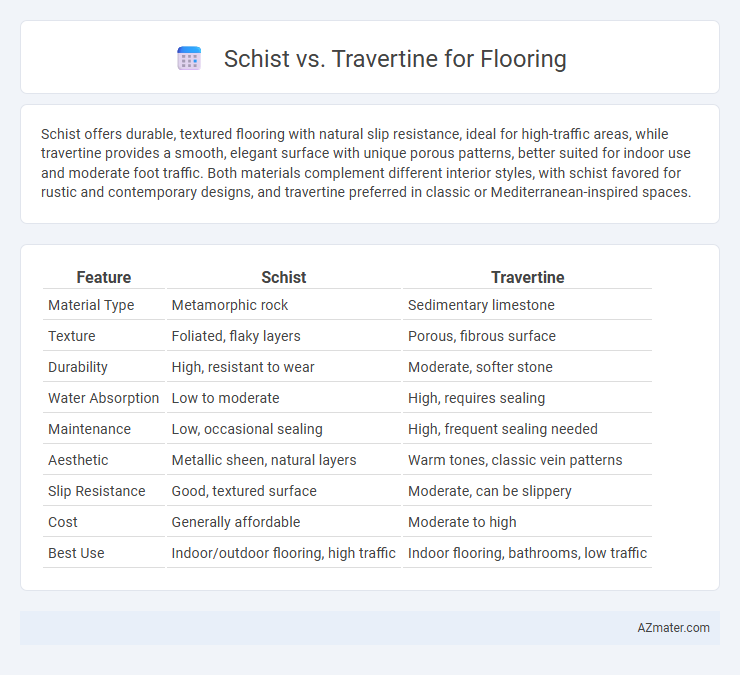Schist offers durable, textured flooring with natural slip resistance, ideal for high-traffic areas, while travertine provides a smooth, elegant surface with unique porous patterns, better suited for indoor use and moderate foot traffic. Both materials complement different interior styles, with schist favored for rustic and contemporary designs, and travertine preferred in classic or Mediterranean-inspired spaces.
Table of Comparison
| Feature | Schist | Travertine |
|---|---|---|
| Material Type | Metamorphic rock | Sedimentary limestone |
| Texture | Foliated, flaky layers | Porous, fibrous surface |
| Durability | High, resistant to wear | Moderate, softer stone |
| Water Absorption | Low to moderate | High, requires sealing |
| Maintenance | Low, occasional sealing | High, frequent sealing needed |
| Aesthetic | Metallic sheen, natural layers | Warm tones, classic vein patterns |
| Slip Resistance | Good, textured surface | Moderate, can be slippery |
| Cost | Generally affordable | Moderate to high |
| Best Use | Indoor/outdoor flooring, high traffic | Indoor flooring, bathrooms, low traffic |
Introduction to Schist and Travertine Flooring
Schist flooring features natural metamorphic stone with a distinctive layered texture and high durability, making it suitable for high-traffic areas. Travertine flooring consists of sedimentary limestone with a porous surface and warm color variations, offering a classic and elegant aesthetic often used in bathrooms and patios. Both stones require sealing to protect against staining and moisture absorption, enhancing longevity and maintaining natural beauty.
Geological Origins: Schist vs Travertine
Schist, a metamorphic rock formed from the recrystallization of sedimentary or igneous rocks under intense heat and pressure, features pronounced foliation and mineral alignment. Travertine, a sedimentary rock, originates from the rapid precipitation of calcium carbonate in mineral-rich hot springs or limestone caves, resulting in its characteristic porous texture and banded patterns. Understanding these geological origins clarifies the differences in durability, appearance, and suitability of Schist versus Travertine for flooring applications.
Appearance and Aesthetic Differences
Schist flooring showcases a textured, layered appearance with natural glitter from mica and a variety of earthy tones ranging from green to silver, offering a rugged, rustic aesthetic ideal for organic or modern interiors. Travertine floors exhibit a smooth, porous surface with distinctive pitted holes and veins in warm hues like beige, cream, and ivory, creating a classic, elegant look preferred for Mediterranean or traditional design schemes. The contrast between schist's coarse, reflective layers and travertine's softer, matte finish defines their unique visual appeal and influences the atmosphere of any flooring installation.
Durability and Longevity Comparison
Schist flooring offers high durability due to its foliated, layered structure, making it resistant to scratches and wear in high-traffic areas. Travertine, a form of limestone with natural pores and softer composition, tends to be less durable but can last for decades with proper sealing and maintenance. The longevity of schist surpasses travertine in most residential and commercial applications, providing a tougher surface with enhanced resistance against chipping and cracking.
Installation Process and Challenges
Schist flooring requires precise cutting due to its layered, foliated texture, making installation labor-intensive and often necessitating professional expertise to ensure stability and alignment. Travertine installation involves careful sealing and grout application to prevent staining and water absorption, with challenges arising from its porous surface that demands thorough surface preparation. Both materials require specialized tools, but schist's uneven thickness can complicate leveling, while travertine's softness makes it prone to chipping if not handled carefully during installation.
Maintenance Requirements for Schist and Travertine
Schist flooring requires regular sealing and prompt cleaning to prevent staining and water damage due to its foliated texture and natural clefts. Travertine demands consistent sealing as well, especially because its porous surface can absorb spills and dirt, making it prone to etching and staining without proper upkeep. Both materials benefit from pH-neutral cleaners and avoid harsh chemicals to maintain their durability and aesthetic appeal over time.
Slip Resistance and Safety Factors
Schist offers superior slip resistance for flooring due to its naturally rough texture and uneven surface, making it ideal for high-traffic areas prone to moisture. Travertine, while aesthetically pleasing with its porous, smooth finish, requires sealing to improve grip and prevent slips, especially in wet environments. Evaluating flooring safety, schist is preferred for environments prioritizing slip resistance, whereas travertine suits spaces focused on elegance with moderate safety considerations.
Environmental Impact and Sustainability
Schist flooring is derived from natural metamorphic rock, requiring minimal processing and offering durability with low environmental impact due to its long lifespan and recyclability. Travertine, a sedimentary limestone formed in hot springs, involves quarrying techniques that can disrupt ecosystems and consume more energy in refinement, though it remains biodegradable and recyclable. Choosing schist over travertine improves sustainability by reducing carbon footprint and preserving natural habitats while maintaining aesthetic and functional qualities in flooring applications.
Cost Analysis: Schist vs Travertine Floors
Schist flooring generally costs between $7 and $15 per square foot, offering a durable and visually striking option with its layered, natural texture. Travertine floors range from $10 to $30 per square foot, reflecting their elegant, porous stone structure and the labor-intensive installation process. When comparing cost efficiency, schist provides an affordable alternative with lower maintenance expenses, while travertine demands a higher initial investment but can enhance property value due to its timeless appeal.
Best Uses and Recommendations for Each Stone
Schist flooring offers exceptional durability and a distinctive, textured appearance ideal for high-traffic indoor areas and rustic-style interiors, while its natural slip resistance suits kitchens and entryways. Travertine, prized for its elegant, smooth finish and warm earth tones, is best used in low-traffic spaces such as bathrooms, living rooms, and patios to enhance aesthetic appeal without compromising comfort. For longevity and maintenance, schist requires occasional sealing and is better suited for areas demanding resilience, whereas travertine benefits from regular sealing to prevent staining and is favored for decorative flooring where a sophisticated look is desired.

Infographic: Schist vs Travertine for Flooring
 azmater.com
azmater.com